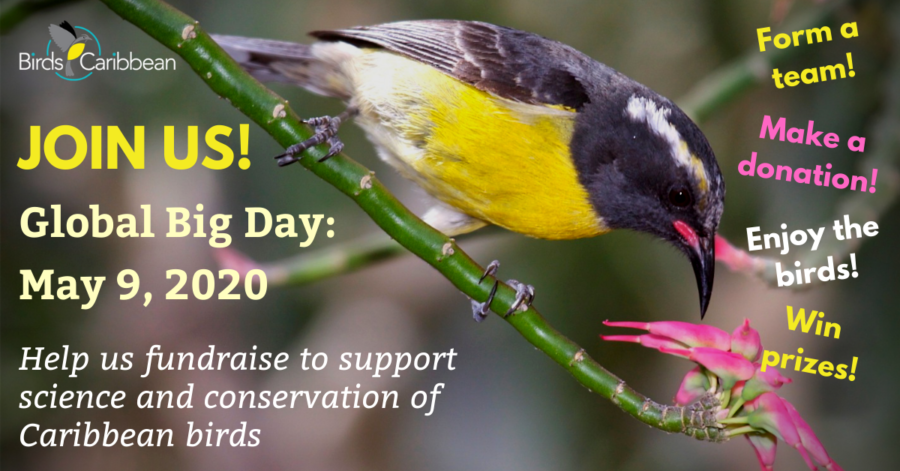With the shutdown and stay at home order in place because of
the COVID-19 pandemic, the local birders took this time to sit back and enjoy
the birds around their homes. In this two-part series two birders, Dr. John
Webster and I will talk about our experience “Staying Home and Bird”. Below is John's account.
---------------------------------------
 |
| Bananaquit |
In this time of “lockdown” Sonia, (my wife) and I have decided to make
the most of the landscape we have created around the acre or so of land that
surround our home. Around our deck, I have setup 4 hummingbird feeders which
are frequented by at least a dozen Bananaquit (Coereba flaveola) in batches of feeding frenzies.
 |
| Green-throated Carib |
There are at least 4 x Green-throated Caribs (Eulampis holosericeus) that are whizzing around like jet fighters in
a raging battle, they are so very territorial, and two Antillean Crested Hummingbird (Orthorhyncus cristatus) hummingbirds are getting in between the aerial
battles to feed at the feeders and various flowers scattered around the
landscape.
 |
| Barbados Bullfinch |
Barbados Bullfinchs (Loxigilla barbadensis) are
back and forth between the. Seed feeder, hung in the tree with the hummingbird feeders,
a bowl on the porch with bread crumbs and the hummingbird feeders where they go
for a quick drink and sugar rush for energy. The seed feeder is being
frequented by a pair of Zenaida Doves (Zenaida aurita), married for life, and a pair of Common
ground doves that periodically appear to stock up on some seeds. We also have a
few Shiny Cowbird (Molothrus bonariensis), male and female,
that arrive unannounced, to snack on the seeds as well. Between feeding, they
serenade us with their beautiful calls as though saying “thank you for feeding
us”.
In the surrounding garden we are serenaded by the varied
calls of the Rose-ringed Parakeets (Psittacula krameri) as they arrive, sometimes singly or in groups of up to 6 or 7, to see whether
any of the Jamaican Ackee fruit has opened so they can get at the edible yellow
parts inside, or to see if they can find any green unripe pods of the Pride of
Barbados shrub.
 |
| Gray Kingbird |
Two or more Gray
Kingbirds (Tyrannus dominicensis) take up their perches on nearby dry twigs and keep us aware of
their presence with their regular shrill calls, swooping down periodically to
snap up an insect or bee that might have ventured within their territory.
Sometimes we will observe them fly over to the adjacent McArthur Palms that
currently have large masses of red fruit, and watch them hover whilst plucking
fruit and return to their perch. This is repeated several times and then they
perch quietly observing the landscape ....5-10 minutes later they start to
regurgitate the seeds having internally removed the soft red flesh of the
fruit!
We have a few pairs of Black-faced Grassquits (Melanospiza bicolor) that pop up
from time to time usually feeding on the lawn, especially when it hasn’t been
cut for a while, like now, apparently feeding on grass seed or other things
they pluck out of the lawn.
In the first hours after sunrise, we can hear and observe
several Caribbean Elaenias (Elaenia martinica)(the TRUE
peewhitler) actively moving around our trees, particularly in the Gliricidia
tree adjacent to our deck and especially when it’s flowering, as they go about
catching their breakfast of insects. There’s also a shrub that we have, that’s
related to the WI cherry family, and which bears tiny fruit like miniature cherries
that this species enjoys in addition to the insects. Sometimes we are treated
to a visit by one or more Black-whiskered Vireos ( Vireo altiloquus) that simply tuck themselves away between the foliage of the
Gliricidia or one of the many other trees, literally hidden from sight, whilst
they serenade us with their frequent calls.
Occasionally one or more Eurasian collared doves will fly
past but they never seem to be interested in our garden!
We are visited typically in the early hours of the morning
and late afternoon by several Scaly-naped Pigeons (Patagioenas squamosa)(Ramiers’ or ‘Willies’ in Bajan parlance) as they also pluck the fruit of the McArthur
palms and the Ylang Ylang trees, the fragrance of whose flowers permeate our
landscape as the day comes to an end.
 |
| Green Heron |
Typically in the late afternoon, we can hear the shriek call
of our approaching resident Green Heron (Butorides virescens) ...for years we have had one that roosts in one of our mango trees ...it has
apparently learnt that with the adjacent gully it can find roaming mice and
young rats which it enjoys. Hence it’s a welcome resident to our property.
 |
Green-throated Carib feed
on the flower of Gliricidia tree |
As the day comes to an end and darkness approaches we can
hear the frantic feeding of the hummingbirds, primarily the Green-throated Caribs (Eulampis holosericeus) as they feverishly rush backward and forward trying to get in their last
feed before nightfall.
Bird species recorded between March 28th to April 10th
- Rock Pigeon (Feral Pigeon)
- Scaly-naped Pigeon
- Eurasian Collared Dove
- Common Ground Dove
- Zenaida Dove
- Green-throated Carib
- Antillean Crested Hummingbird
- Cattle Egret
- Green Heron
- Rose-ringed Parakeet
- Black-whiskered vireo
- Caribbean Elaenia
- Gray Kingbird
- Shiny Cowbird
- Carib Grackle
- Bananaquit
- Black-faced Grassquit
- Barbados Bullfinch
All photographs by John Webster
Dr. John Webster is
one of the leading Birders and Bird Photographers on the island of Barbados. He is a member of Birds Caribbean and the principle guide with Barbados
Birding & Photography Tours. He can be contacted at barbadosbirds@gmail.com
|
































